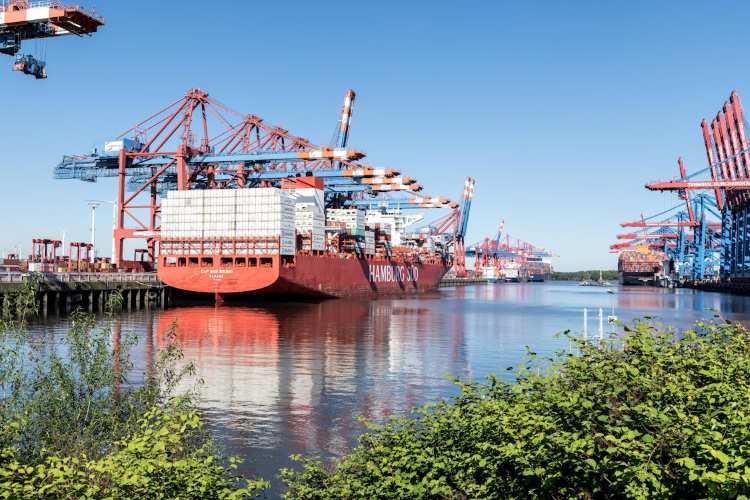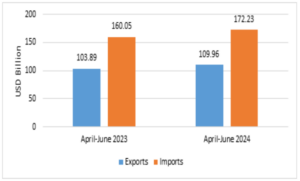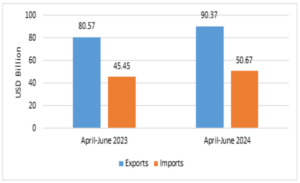
Trade deficit widens: India’s foreign trade has undergone significant shifts in recent years. The trade data for the first half of 2024 reveal both the positives and negatives of India’s trade ties with major partners. Between January and June 2024, India had a trade surplus with 151 countries, accounting for 55.8% of its exports but only 16.5% of its imports, totalling $72.1 billion. The United States and the Netherlands emerged as the most significant surplus partners, with surpluses of $21.0 billion and $11.6 billion, respectively. Trade equations with these developed markets show India’s growing export capabilities, particularly in markets where it has established strong trade relations, says a study by Global Trade Research Initiative.
However, the story is markedly different with the 75 countries where India recorded a trade deficit, amounting to $185.4 billion. This deficit, substantially larger than India’s overall trade deficit, reveals a heavy import dependence on specific imports, particularly from countries like China, Russia, and Iraq. These three alone contributed to a combined deficit of nearly $89 billion, highlighting the critical need for India to diversify its import sources and strengthen domestic production capabilities.
READ I GDP growth slows amid monsoon hopes and fiscal fears
High trade deficit with industrial product suppliers
A significant share of India’s trade deficit is with countries that supply industrial products, a category dominated by China. In the first half of 2024, India’s trade deficit with China reached a staggering $41.9 billion, with 98.5% of imports from China being industrial goods. China alone accounted for 29.8% of India’s industrial goods imports, making it the largest supplier in all eight industrial goods categories, from electronics to machinery.
Merchandise trade during April-June 2024

The overwhelming dependence on Chinese imports is worrying for India’s Micro, Small, and Medium Enterprises (MSMEs). These enterprises, which produce many of the same goods that are imported from China, are struggling to compete against the influx of cheaper Chinese products. This competition is not only squeezing the profitability of Indian MSMEs but also threatening their very survival, leading to job losses and stunted economic growth.
Post-pandemic trade trends
India’s trade with various global regions have shown significant improvement in the post-pandemic period. India recorded trade surpluses with eight major regions in the post-pandemic years, up from six in the pre-pandemic era. Notably, the European Union and Central Asian countries transitioned from trade deficits to surpluses, reflecting India’s enhanced export competitiveness and deeper integration into global value chains.
This shift is attributed to a series of policy reforms, including the simplification of the indirect tax regime and improvements in logistics infrastructure. These reforms have facilitated easier and more cost-effective exports, contributing to India’s record-breaking export figures of $778 billion in 2023-24.
Services Trade during April-June 2024

Despite these positive developments, challenges persist, particularly in regions like ASEAN and Northeast Asia, where India continues to face rising trade deficits. The trade deficit with ASEAN countries has more than doubled from $19 billion pre-pandemic to $35 billion post-pandemic, despite the existence of a free trade agreement (FTA). This growing deficit signals underlying structural issues in India’s trade policies with these regions, where competitive disadvantages in terms of cost of capital, power, logistics, and compliance continue to undermine India’s export performance.
Reducing dependency and enhancing competitiveness
The heavy reliance on imports for critical industrial goods and natural resources highlights the need for strategic interventions. India must invest in deep manufacturing capabilities to reduce its dependency on imports, particularly from China. Strengthening domestic production is crucial for safeguarding economic sovereignty and promoting sustainable growth.
Additionally, there is a pressing need to manage tariffs wisely and negotiate trade agreements that protect domestic industries while fostering competitive exports. The ongoing FTA negotiations with countries like Peru, where imports of gold and other precious metals are substantial, should be approached with caution to avoid exacerbating trade deficits.
India’s ambition to achieve a $2 trillion exports by 2030 will require sustained efforts to build on the successes of the post-pandemic period. This includes addressing the rising trade deficits with key regions, further improving the ease of doing business, and continuing to enhance export infrastructure. By focusing on these areas, India can solidify its position as a major player in global trade, while also ensuring that its economic growth is inclusive and resilient.
While the country has made significant strides in achieving better trade balance with several regions, the persistent and growing deficits with industrial product suppliers, particularly China, highlight the need for strategic policy interventions. By investing in domestic manufacturing, managing trade relationships judiciously, and addressing structural disadvantages, India can overcome these challenges and continue on its path toward becoming a global trade powerhouse.
